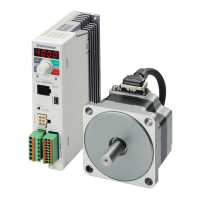Operation
−
43
−
If the FWD input and REV input are turned ON at the same time, the motor stops instantaneously regardless of the
status of the STOP-MODE input.
ON
OFF
ON
OFF
ON
STOP-MODE input
REV input
FWD input
Motor operation
CW CW
Instantaneous
stop
Deceleration
stop
8.6 Parallel operation
If two or more motors are to be operated at the same speed by using a single external potentiometer (external DC
voltage), this type of operation is called “parallel operation.”
Parallel operation is achieved by allowing multiple drivers to share the power line and speed setting line.
•
The connection examples explained here assume a single-phase specication. In the case of a three-phase
specication, connect the power line to a three-phase power supply.
•
Connect the external I/O signals to each driver.
•
To perform parallel operation using the external potentiometer, set the external voltage selector switch (SW2-2) to
5 VDC.
•
Set the external voltage selector switch (SW2-2) the same way for all the drivers.
Using an external potentiometer
Connect the drivers as shown below.
When performing parallel operation using the external potentiometer, the number of drivers should not exceed
20 units.
470 Ω, 1/4 W
VRn
1 kΩ, 1/4 W
Speed setting line
External potentiometer
VRx
13
2
Driver 1 Driver n
VM
VL
L
N
L
N
VH
VM
VL
VH
If the number of drivers used is “n,” calculate resistance (VRx) of the external potentiometer using the formula below:
Resistance (VRx) = 20/n (k
Ω
), n/4 (W)
Example: If two drivers are used, resistance (VRx) is calculated as 10 k
Ω
, 1/2 W [20/2 (k
Ω
), 2/4 (W)].
(Use a resistor of the calculated wattage or more.)
If the speed will vary among the respective motors, make adjustments by connecting a resistor of 470
Ω
, 1/4 W to
terminal VM on driver 1 and connecting a variable resistor of 1 kΩ, 1/4 W to driver 2 and subsequent drivers.

